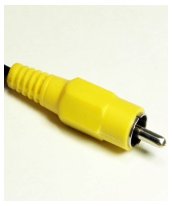Composite Video
 Composite Video is the lowest quality transmission format for Standard Definition (SD) analog video. It was originally designed to take advantage of the separation of video and audio on VHS videotapes, allowing the video to be transmitted separately. The alternative, conversion to a NTSC or PAL RF signal, requires modulating the video and audio together, resulting in interference between the two. It's transmitted either on a dedicated Composite Video cable with RCA connectors on each end or a SCART connector.
Composite Video is the lowest quality transmission format for Standard Definition (SD) analog video. It was originally designed to take advantage of the separation of video and audio on VHS videotapes, allowing the video to be transmitted separately. The alternative, conversion to a NTSC or PAL RF signal, requires modulating the video and audio together, resulting in interference between the two. It's transmitted either on a dedicated Composite Video cable with RCA connectors on each end or a SCART connector.
With the introduction of S-VHS, LaserDisc, and eventually DVD the Composite Video was replaced as a standard with the higher quality S-Video. Unlike Composite Video, S-Video transmits Luminance (brightness) and Chrominance (color) information separately, reducing interference, and therefore raising picture quality even further. For VHS equipment S-Video won't be an option, so Composite Video is the standard transmission media.
Due to low Bandwidth and interference between different compenents of the video signal, Composite Video is never recommended for High Definition, or even Widescreen SD video applications.
Related Guides
Digital Video Fundamentals - Resolution and Aspect Ratio

